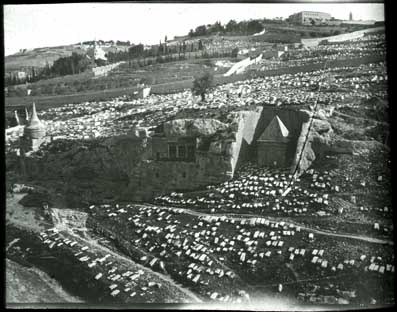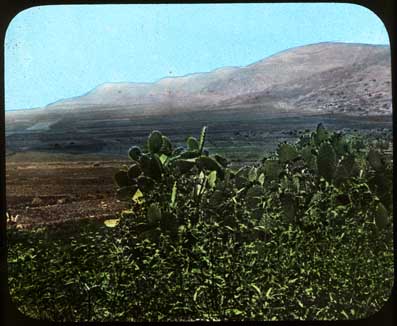
The Plain of Esdraelon
The Plain of Esdraelon, now known as the Valley of Jezreel. According to the Bible, this valley was the scene of a victory by the Israelites, lead by Gideon, against the Midianites, the Amalekiltes, and the Children of the East [Judges 6:3], but was later the location at which the Israelites, lead by King Saul, were defeated by the Philistines [1 Samuel 29:1-6].
"Now the Philistines gathered all their forces at Aphek; and the Israelites were encamped by the fountain which is in Jezreel....". [1 Samuel 29:1]
(GWW slide)
Jericho, in the Jordan Valley
Located 16km from the Dead Sea. Jericho was one of the cities conquered by Joshua and his troops when claiming the Land of Caanan as the Promised Land. The battle (or siege) of Jericho is described in the Book of Joshua [Joshua 5:13-6:27].
"And the Lord said to Joshua, "See, I have given into your hand Jericho, with it's king and mighty men of valour. You shall march around the city once, Thus shall you do for six days. And seven priests shall bear seven trumpets of rams' horns before the ark; and on the seventh day you shall march around the city seven times, and priests blowing trumpets. And when they make a long blast with the ram's horn, as soon as you hear the sound of the trumpet, then all the people shall shout with a great shout and the wall of the city will fall down flat...."
The city was completely destroyed, with every man, woman, and child being killed. Only Rahab and her family were spared, because she had hid two spies sent by Joshua. Joshua then burnt the remains of the city and cursed any man who would rebuild the city of Jericho at the cost of his firstborn son.
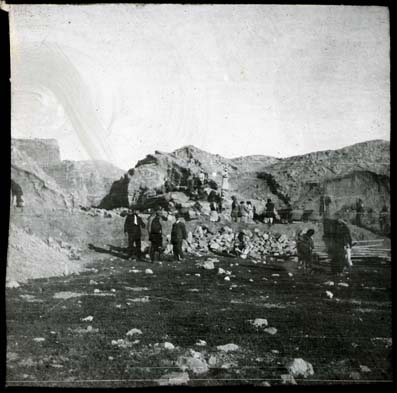
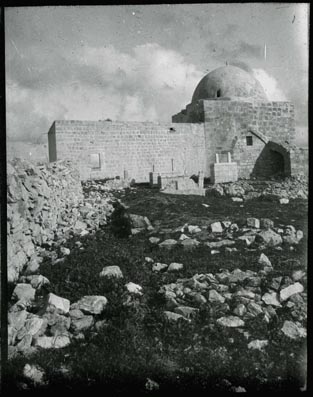
The Tomb of Rachel
The traditional gravesite of the Biblical Matriarch Rachel, located in Northern Judea on the outskirts of Bethlehem.
The actual tomb consists of a rock with eleven stones upon it, one for each of the eleven sons of Jacob who were alive when Rachel died in childbirth. Over the centuries, the rock was covered by a dome supported by four arches. In 1841, Sir Moses Montefiore was granted permission by the Ottoman Turks to restore the tomb. He built the large, two-room building that we know today.
"So Rachel died, and she was buried on the way to Ephrath (that is, Bethlehem). and Jacob set a pillar upon her grave; it is the pillar of Rachel's tomb, which is there to this day." Genesis 35:19-20]
Bethel (meaning 'House of God'), site of a town in ancient Israel, and located 19km north of Jerusalem.It was from Bethel (originally called Luz) that Jacob received a divine revelation from the "God of Bethel" (GWW Slide)
"Then the angel of God said to me in the dream, 'Jacob', and I said 'Here I am!' And he said... I am the God of Bethel, where you anointed a pillar and made a vow to me. Now arise, go forth from this land, and return to the land of your birth." [Genesis 31:11-13]
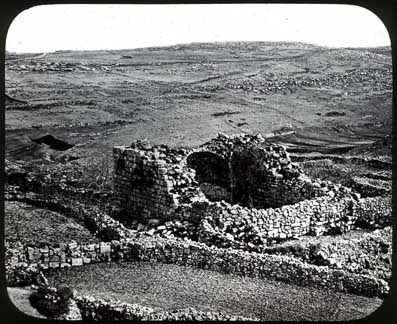
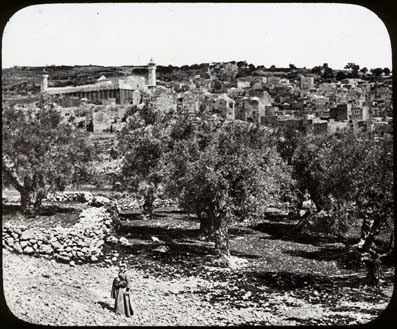
The town of Hebron, located 30km SSW of Jerusalem in the Biblical region of Judea. Shown at upper left is the 'Sanctuary of Abraham' or 'Mosque of the Patriarchs', built over a series of caves containing the tombs of the patriarchs Abraham, Isaac and Jacob, and the matriarchs Sarah, Rebekah and Leah. (GWW slide)
"When Jacob finished charging his son's, he drew up his feet into the bed, and breathed his last and was gathered to his people.... Thus his sons did for him as he had commanded them; for his sons carried him to the land of Canaan, and buried him in the cave of the field at Mach-pe-lah, to the east of Mamre..." [Genesis 49:28-33 to 50:1-14]
A view of the Western Wall, Jerusalem.
The 'Western Wall' commonly refers to a 187 feet (57 m) exposed section of ancient wall situated on the western flank of the Temple Mount, a Jewish religious site located in the old city of Jerusalem. The wall, which dates from 516-70 BC, is sometimes referred to as the Wailing Wall. This is a reference to Jews who come to the site to mourn the destruction of Solomon's Temple (built in the 10th century BC) by the Babylonian's in 586 B.C. The conquering Babylonian army also forced the resident Jewish population into exile for almost 70 years.
"In the fifth month, on the seventh day of the month - which was the ninteenth year of King Nebuchadnezzar, king of Babylon - Nebuzaradan, the captain of the bodyguard, a servant of the king of Babylon, came to Jerusalem. And he burned the house of the Lord, and the king's house and all the houses of Jerusalem; every great house he burned down..... And all the army of the Chaldeans, who were with the captain of the guard, broke down the wall around Jerusalem. And the rest of the people who were left in the city and the deserters who had deserted to the king of Babylon, together with the rest of the multitude, Nebuzaradan the captain of the guard carried into exile." [2 Kings:8-11]
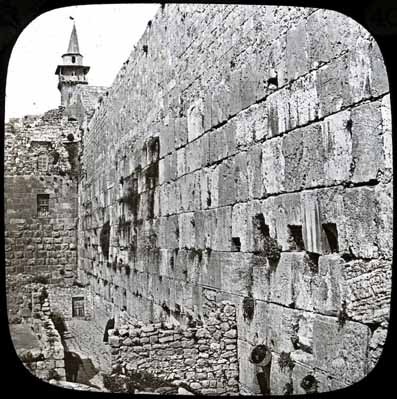
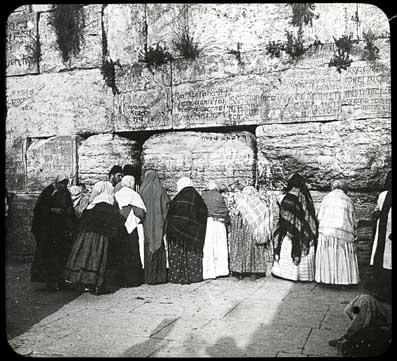
Jewish men and women praying at the Western Wall, Jerusalem.
King Herod's Temple, which had been built atop Temple Mount after the destruction of Solomon's Temple, was itself destroyed along with the rest of Jerusalem during the time of the Jewish-Roman war in 70 A.D. The Western Wall, however, was spared. Note the inscriptions chiseled on the stones.
"Caesar gave orders that they should now demolish the entire city and Temple, but should leave as many of the towers standing as were of the greatest eminence; that is, Phasaelus, and Hippicus, and Mariamne; and so much of the wall as enclosed the city on the west side. This wall was spared, in order to afford a camp for such as were to lie in garrison [in the Upper City], as were the towers of feet [the three forts] also spared, in order to demonstrate to posterity what kind of city it was, and how well fortified, which the Roman valor had subdued..." [Titus Flavius Josephus, 37 - c.100AD]
The Old Pentateuch Roll :
Fragments of the historic Samaritan Pentateuch or "Abisha Scroll" from Nablus, the oldest being from the 11th century A.D.
The Samaritan Pentateuch is the text of the Pentateuch (also called the Torah or Law), being the first five books of the Bible and written in the Samaritan alphabet.
On their return from the Exile, the Jews refused to allow the Samaritans to participate in worship at Jerusalem. The Samaritans separated themselves socially from the Jews, who in return shunned them. Denied access to Jerusalem, Samaritan worship was centred on their temple on Mount Gerizim. This temple was razed to the ground around 100 BC by the Jews for religious reasons. Then a system of worship was instituted by the Samaritans similar to that of the temple at Jerusalem. It was founded on the Torah, possibly on copies that had been brought by Jewish priests that had left the Jerusalem temple for that on Mount Gerizim.
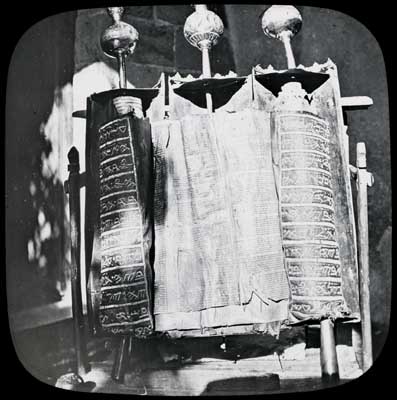
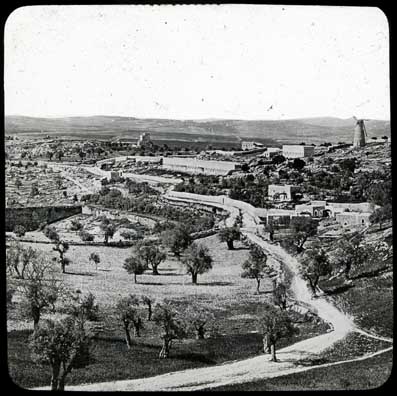
The Valley of Gihon, situated just outside the Jerusalem city walls. Gihon is the site of a spring which supplies water through "Hezekiah's Tunnel" to the Pool of Siloam in the old city. In times of warfare and siege several such underground tunnels enabled the residents of Jerusalem to reach the Gihon Spring unobserved. Note the windmill on the hillside.
"And when Hezekiah saw that Sennacherib had come and intended to fight against Jerusalem, he planned with his officers and his mightly men to stop the water of the springs that were outside the city; and they helped him. A great many people were gathered, and they stopped all the springs and the brook that flowed through the land, saying, 'Why should the kings of Assyria come and find much water?' ". [Chronicles 2:2-4]
The Valley of Jehosaphat
The Valley of Jehosaphat, east of Jerusalem - where, according to the Prophet Joel, the God of Israel will gather all nations for judgment. (GWW Slide)
"For behold, in those days and at that time, when I restore the fortunes of Judah and Jerusalem, I will gather all the nations and bring them down to the valley of Jehosaphat, and I will enter into judgement with them there, on account of my people and my heritage, Israel, because they have scattered them among the nations, and have divided up my land...." [Joel 3:1-2]
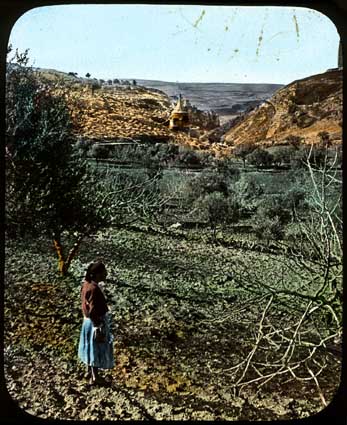
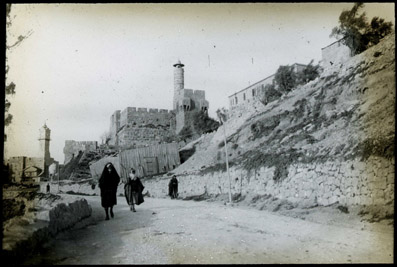
The Tower of David Citadel, Jerusalem.
The Tower of David (left of centre) is an ancient citadel located near the Jaffa Gate leading into the old City of Jerusalem. King Herod ordered it built in the 2nd century BC to strengthen a strategically weak point in the old City's defenses. It was subsequently destroyed and rebuilt by, in succession, the Christian, Muslim, Maluk, and Ottoman conquerors of Jerusalem.
During the Crusader period, thousands of pilgrims undertook the pilgrimage to Jerusalem by way of the coastal port at Jaffa. To protect pilgrims from the menace of highway robbers, the Crusaders built a tower surrounded by a moat atop the citadel, and posted lookouts to guard the road to Jaffa. The citadel also served as the seat of the Crusader Kings of Jerusalem.
The Jewish Cemetery, Mount of Olives
In the Book of Zechariah, the Mount of Olives is identified as the place from which God will begin to redeem the dead at the end of days. For this reason, Jews have always sought to be buried on the Mount overlooking the Kidron Valley.
This image shows the pyramid shaped tomb of the Prophet Zechariah and the conical-roofed 'Absalom's Pillar' [the tomb of Absalom] at far left.
"On that day his feet shall stand on the Mount of Olives which lies before Jerusalem on the east; and the Mount of Olives shall be split in two from east to west by a very wide valley; so that one half of the Mount shall withdraw northward, and the other southward.... and you shall flee as you fled from the earthquake in the days of Uzziah king of Judah. Then the Lord your God will come, and all the holy ones with him." [Zechariah 14:4-5]
